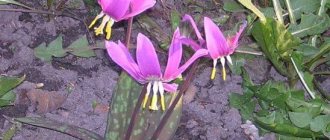Every gardener dreams of having at least one plant growing in his front garden that would be admired, and perhaps even envied, by all his neighbors.
The window sill grass will make this dream come true. Although this plant can be called a grass at a stretch, it is more likely a bush.
Especially popular is the purple sapling, which during flowering resembles a lilac bush.
Poskonnik is a perennial plant that belongs to the Astrov family. The humid prairies of North America and the African tropics are considered the homeland of this ornamental crop, hence its love for sunlight, air and space.
This spectacular bush will decorate any landscape composition. And if you take into account its ease of care and amazing vitality, then even a novice gardener can cope with its planting and further cultivation.
How to choose the right window sill when purchasing
To purchase a window sill, a specialized garden store is best suited; this will provide a certain guarantee of the quality of the planting material.
Rules for choosing sapling rhizomes
The product being sold must be in transparent packaging so that it is possible to evaluate its quality according to the following criteria:
- There is no mold or rot on the rhizome.
- The roots are intact, without mechanical damage.
- The rhizome is hard, elastic, and at the same time unbreakable.
- When purchased in spring, swollen buds are visible.
Do not hesitate to carefully examine and touch the selected rhizome; this determines whether the plant will take root in your area.
Selection of seedlings
Sapling seedlings are usually sold in individual pots. Carefully examine the condition of the plant:
- The leaf is strong, looking up cheerfully. Softness and lethargy indicate a lack of watering.
- The earthen lump is moist, not overdried.
- The roots are hidden in the soil.
If the roots stick out from the container, you should not purchase such seedlings; they are unlikely to take root.
Use in folk medicine
Purple sapling is included in the list of medicinal plants in Russia. It has long been used in folk medicine as an anti-inflammatory, expectorant, and diuretic. Currently, its medicinal value has been greatly lost, since much more effective drugs have been synthesized. It should also be taken into account that all parts of the purple sapling contain toxic substances - alkaloids, therefore any homemade products based on this plant should be used with caution and only after consulting a doctor.
Selection and preparation of a landing site
In the wild, sapling prefers moist soil.
Based on this, choose a low-lying, damp place for planting on your site; the shore of a pond or artificial reservoir is especially suitable.
The height of the plant depends on how wet the soil is: the higher the humidity, the taller the bush.
Keep in mind! The window sill will grow in width, so there should be a lot of free space for planting, about a square meter.
Lighting is important. This perennial loves the sun and can grow in partial shade, but if it does not have enough light, the window sill will not produce flowers and will look wilted and sick.
Like most plants, this perennial needs loose, soft soil. It will not grow in a sandy area, since sand hardly retains water.
To make the bush delight you with its appearance, powerful stems and lush flowering, plant it on fertile, humus-rich soil.
How to prepare the soil
Such a powerful plant requires increased nutrition.
In order to carry out proper planting of the sill and further care in the open ground, the bed must be prepared with special care:
- conscientiously dig up the ground, picking out all the weeds;
- add compost or humus to the bed;
- add sand to heavy clay soil, and dilute sandy loam with clay to retain moisture longer;
- add mineral fertilizers with a long digestion period, they will feed the plant for several years.
After this, level the surface of the bed and mark the planting holes so that there is at least 60 cm between them.
Description and characteristics of the plant
The sapling (Eupatorium cannabinum L.) is a species of plant in the aster family (Asteraceae Dum.). The Russian name of the perennial comes from the word poskon (hemp), other names are also known in the world - hemp, water marjoram, hemp marjoram, St. John's grass, windy rose. The plant grows wild in Europe, large parts of Asia, Algeria, and Morocco.
This is an extremely impressive, leafy perennial. The plant is frost-resistant, so you can easily grow saplings in the Moscow region, the middle zone and many other regions.
The stem is smooth, erect, 50-170 cm high, covered with short hairs on top, grooved, reddish, rarely branched, often hollow.
The leaves are dark green, opposite, trifoliate, lanceolate, 5-15 cm long, 1-4 cm wide, pointed, the edges are often jagged. The lower leaves are short-petiolate, the upper ones are sometimes sessile, arranged in a circle of four.
The flowers of the sapling are bisexual, tubular, cylindrical, small, 5-6 mm long, 1.5-2.5 mm wide, collected in 3-7 flower baskets, forming dense clusters with a diameter of 7.5 cm. The pistil is elongated.
The crown of the flower is dirty pink, sometimes white or purple, quite deep, with five funnel-shaped teeth. The calyx is 3-5 mm long, the hairs are arranged in one row.
The sapling blooms from the first ten days of July until August - 7 weeks. Flowers emit a pleasant smell, attracting various insects. The plant is an excellent honey plant and attracts bees and butterflies to the garden.
The fruit is a red-brown achene, 2-3 mm long, 0.5-1 mm wide. The seeds are spread by the wind.
Habitat – grows on the banks of water bodies, in wet meadows, edges of wet forests, in thickets, wet forests, meadows, ditches.
It is worth knowing that... The essential oils contained in the plant attract bees, bumblebees, and butterflies.
Thanks to its beautiful inflorescences, sapling can be grown as an ornamental plant. In addition to the natural form, ornamental varieties are grown.
Rules for planting window sills in the country
Typically, sills are planted with seedlings, cuttings or rhizomes after warm weather sets in:
- At the designated locations, dig holes 0.25 m deep.
- Pour in humus and bone meal, about a handful each.
- Carefully remove the seedlings from the containers, being careful not to damage the stems and roots.
- Lightly stir the earthen lump on the roots so that they straighten out: this way the plant will grow faster.
- Place in the hole and cover with soil so that the growth bud is covered by 5 cm; this will protect the seedling from freezing in winter.
- Water, being careful not to disturb the soil around the seedling.
- Cover the tree trunk circle with a layer of mulch made from sawdust, humus or peat, this will maintain soil moisture and prevent weeds from growing.
Until the plant takes root, you should water it more often, not allowing the soil to dry out.
The sapling is responsive to fertilization, but you can start fertilizing only after rooting.
Feed with complex mineral fertilizers such as Kemira Lux, Zdraven, nitroammofoska, after making an aqueous solution based on them.
Moisturizing and fertilizing
This plant prefers frequent moisture. A place next to a pond will suit him very well. It has been noted that a slight stagnation of moisture in the window sill will not cause as much harm as drought.
After heavy watering or rain, it is recommended to loosen the soil near the plant trunk to prevent the formation of a crust on the ground. At the same time, you can remove weeds growing in the neighborhood.
Poskonnik - a handsome healer - video
Complex mineral complexes similar to the following products are suitable for feeding the saplings: “Zdraven”, Nitroammofoska” and “Fertika Lux”. A plant that has received sufficient nutrition has a different appearance. Shine appears on its foliage, the foliage acquires a rich color, and the open buds delight with colors.
In one season, the sill needs to be fertilized three times. The first time this should be done is at the beginning of the season. The second time, fertilizers are applied at the time of budding, and the last time, mineral additives are introduced into the soil after the sapling has faded. If there are no mineral complexes at hand, the plant will respond well to fertilizing with mullein, humus or wood ash.
Combination with other plants
This ornamental bush looks impressive in a mixborder, in a group planting with other shrubs; it can cover an unsightly building or be used as a hedge.
It goes well with large plants such as Rogersia, Volzhanka, and Astilbe.
Nearby you can plant bladderwort, mock orange, bushes of park roses or lilacs.
The majestic beauty of the window sill is emphasized by low decorative foliage plants, for example, hosta, heuchera.
When using a perennial in a flower garden, take into account its tallness, so plant it in the background.
A sapling bush will look very good if tall grasses, heleniums, rudbeckia, echinacea, and delphiniums are located nearby.
Considering the late appearance of shoots in the spring (approximately May), plant the place where the sapling grows with early primroses: crocuses, snowdrops, scylla or corydalis.
Then in early spring this piece of land will not look dull.
This culture is absolutely not aggressive and does not suppress nearby plants at all.
Posonnik in landscape design
Poskonnik is grown both as a solo plant and as a background for composition with other ornamental crops. A sill bush is beautiful in the middle of a green lawn or in the background of a mixborder. This moisture-loving plant often decorates the banks of natural and artificial reservoirs.
In order to hide an unsightly fence or building, the window sill is planted in a group. Tall varieties of plants, covered with frost and snow, will decorate your garden in winter. The window sill is also beautiful when cut: it retains its fresh appearance for a long time. Shoots and inflorescences of the plant are often used for ikebana. The most suitable partners for saplings are loosestrife, daylily, astilbe, buzulnik and echinacea.
Sill care
The window sill does not require much attention, and caring for it is not difficult. You just need to follow the general recommendations for growing perennials.
How to water
To ensure that the bush not only takes up space on the site, but also delights with abundant flowering, do not forget about watering.
It should be systematic and plentiful, especially if the summer was hot and dry.
Mulching the soil under the bush will help retain moisture. Try to renew the mulch more often, as frequent watering causes it to decompose quickly.
How to feed
If you apply the right fertilizers on time, this will immediately affect the appearance of the plant: a characteristic shine with a copper tint will appear, the leaves will become brighter and more saturated in color, the flowers will become more lush, and their number will increase.
Use mineral fertilizers dissolved in water: Kemira Lux, Zdraven, nitroammofoska, urea.
You can also feed with wood ash, compost, bone meal, and add humus.
Three main feedings are enough - the very beginning of spring; summer, when the bush gains color, and autumn - before wintering.
How to prepare for winter
Before the onset of winter, trim the bush, leaving stems 10-15 cm high. Additional shelter is not required, since the adult window sill is frost-resistant.
Take care only of young seedlings, covering them with spruce branches. Place about a bucket's worth of humus under each bush, this will help the plants survive the cold.
When to replant
The sapling does not like to be disturbed unnecessarily, so it has a bad attitude towards frequent division and transplants.
These events affect its flowering and appearance. If such a need arises, it is better to do this in early spring, before the growing season begins.
Keep in mind that a sapling bush can grow in one area for 8-10 years, so initially choose the right place for planting.
If, after all, replanting is inevitable, then dig up a large lump of earth along with the roots and move the bush as carefully as possible to another place.
How to trim
As mentioned above, pre-winter pruning is carried out in the fall.
With the onset of spring, shoots emerge promptly, and the window sill quickly restores the “lost” crown.
Recommendation. It makes sense to thin out the shoots, leaving the strongest and tightest. After this, the inflorescences will become larger and the flowering will be more abundant.
In the fall, if you do not want to propagate the saplings by self-sowing, cut off all faded inflorescences.
Do I need to tie it up?
If the bush grows in an open area, then it is better to tie it to a support so that during gusts of wind or in rainy weather the wet heavy inflorescences do not break off.
The right solution would be to plant the perennial next to a fence, wall or fence.
Botanical description
Sills are rhizomatous perennial and annual subshrubs and herbaceous plants with straight stems, opposite, and less often alternate or whorled leaf arrangement. Ovate, linear, elliptical, lanceolate, rhombic, oblong, pinnate, palmate-lobed leaves, entire or serrated along the edge, can be sessile or located on petioles. The surface of the leaf plate in sills can be smooth, rough or pubescent.
About growing sedum - it looks like sedum
Small tubular purple, pink, white or lilac-blue flowers are collected in baskets forming complex panicles, corymbs or brushes. The fruit of plants of this genus is an achene.
- Planting and caring for buddleia alternate-leaved (video)
Reproduction of the sapling
Poskonnik reproduces in several ways:
- seeds;
- dividing the bush;
- green cuttings.
With vegetative propagation, it is possible to preserve the characteristic characteristics of the variety, because cross-pollination will not occur.
Seeds
Seeds can be bought at a gardening store, collected in the fall from a mature inflorescence, or wait for self-sowing.
Start sowing seedlings in mid-March, using small containers and good soil.
There is no need to bury them, just lay them out on the surface of moist soil and lightly sprinkle them with soil. Stretch film or lay down glass to create a greenhouse effect.
After germination (after 15-20 days), the cover must be removed. When the fifth true leaf appears, pick it out into separate containers. Plant in the flowerbed after warm weather sets in.
Self-seeding that gets into the soil after flowering will produce abundant shoots in the spring. Leave the strongest shoots. Such plants will bloom only in the third summer.
Dividing the bush
Bushes that have crossed the five-year mark can be divided. Both spring and autumn are suitable for this procedure, but in the spring it is still better to divide.
After the plant has woken up and started to grow, cut the rhizome with a spatula or knife into several parts with at least three buds.
Without delay, plant them in the prepared soil, watering them thoroughly.
If you decide to purchase a division, for example, from a neighbor when he divides his sill bush, then the best time for this is September.
The plant needs time to take root before the onset of frost.
Cuttings
Another method of propagation is cuttings. Feel free to plant the cuttings directly into the soil in the spring or grow them like seedlings in pots and plant them in the summer.
Propagating saplings using root cuttings is perhaps the easiest way.
In the spring, separate the shoot and its underground part from the main bush, place it in a container with moist soil and place it in a greenhouse.
A quickly rooted seedling will grow there all summer, but plant it on the site chosen for planting only in August.
Features of cultivation
Poskonnik can be grown from seeds, cuttings, young shoots and by dividing bushes. Each method has its own characteristics.
Seed method
Growing saplings by seeds is most often used. In a favorable climate, the seed is planted directly into the ground; in other cases, seedlings are first grown from the seeds.
Recommendations for growing seedlings:
- before sowing, the seeds are stratified - they are placed in a container with sand, irrigated, covered with a lid and removed to a cold place for 30 days;
- seeds for seedlings are sown in early March;
- seeds are planted in containers filled with special soil to a depth of 5 mm, covered with glass and placed in a bright and warm place;
- containers with seeds must be ventilated daily by removing the glass;
- It is recommended to water the seeds as the soil dries;
- glass from containers must be removed after the first shoots appear - 14-21 days after sowing the seeds;
- After the second pair of leaves appears, the sprouts are planted in pots.
Growing saplings with seeds Seedlings
are planted in open soil in the second or third month of spring to avoid the death of the plant from frost.
Before planting the sill, it is necessary to prepare the soil - dig, level, fertilize, and remove weeds. Bushes are planted at a distance of 0.7-0.8 m, followed by watering.
Planting using division and cuttings
It is necessary to divide the plant no more than once every five years in the autumn or spring. The division is carried out as follows:
- carefully dig up the bush without damaging the root;
- remove the remaining soil by placing the bush in a container with water;
- each shoot is cut to a length of no more than 150 mm;
- the bush is divided with an ax or shovel;
- The resulting seedlings are placed in pre-prepared soil.
The bush is propagated using cuttings at the height of summer. You need to cut green cuttings approximately 150 mm long, put them in a container with a sand-peat mixture, cover and put them in a bright room with a temperature of 18-23 degrees for 30 days.
Resistance to pests and diseases
The sapling will not bother you with its diseases; it has good resistance against them.
It is also not susceptible to pest attacks.
The only pest that can appear on this perennial is the leaf miner.
It settles inside the leaf, boring out peculiar “tunnels”.
The miner can be detected by the characteristic pattern on the surface of the leaves.
The most effective way to fight is to collect and burn such foliage.
If the affected area is large, use an insecticide such as Actellik.
Types and varieties
There are more than 600 species of plants in the genus Pokonnik. The most popular among gardeners are:
- wrinkly;
- purple;
- spotted;
- tubular;
- hemp.
Let's talk about them in more detail.
Wrinkled sapling
Eupatorium rugose
The height of the bush reaches 1.5 m, the leaves are oval-ovate, framed by denticles. The color of the shoots is dark, almost brown.
Wrinkled sapling blooms late, closer to August, blooms almost until the end of October, releasing white lush inflorescences.
The most famous variety is Eupatorium Chocolate.
Spotted sapling
Eupatorium Maculatum
It differs from other species in its impressive size (up to 2 m) and slightly “rough” shape.
It has an uneven coloring of the stems, on which pink spots are visible, hence the name of the species - Spotted sapling.
The leaf covering is dense, the color of the foliage is dark green or bluish. Due to its size and density of leaves it can serve as a hedge.
The most famous variety is Atropurpureum.
Purple sapling
Eupatorium purpureum
This species is most popular among gardeners, as it has many similarities with the lilac bush.
The height of the bush is about 150 cm, no additional garter is required. Blooms in July, blooms until the end of August with pale pink or purple inflorescences.
Has increased cold resistance.
Tubular sill
Eupatorium Fistulosum
A powerful plant, up to 3 m high. It blooms in August, blooms until the end of September with lush white inflorescences.
The color of the stems is light burgundy, becoming paler at the end of the growing season.
Hemp sapling
Eupatorium Cannabinus
Cannabinus can be found not only in a summer cottage, but also in the wild near water bodies, in damp and swampy places.
Compared to other species, it is quite low-growing, the height ranges from 0.5 m to 1 m. It blooms from July to the end of August, the color of the baskets is silvery-pink.
The shape of the foliage is similar to that of a hemp bush, hence the name - hemp-shaped sapling.
A flowering window sill will give the garden a special elegance and attractiveness, and the aroma of the inflorescences will attract honey insects, which will also be useful for pollinating other plants on your site.
When and how does it bloom
The most popular types of window sills are:
- hemp, which received its name for its similarity with hemp leaves;
- The wrinkled species is divided into several varieties. For example, the wrinkled Chocolate variety with black leaves is popular. Also known is the Braunlaub variety, which has brown leaves and buds;
- purple with bluish-green stems and shield-shaped inflorescences;
- spotted sapling has several varieties, among them the spectacular spreading Atropurpureum with strong stems and wine-red flowers;
- The tubular appearance is distinguished by the Album variety, which grows into trapezoidal upright bushes three meters high.
Flower shapes
Small flowers are collected in approximately 12 pieces. in the shape of a basket. Corymbose inflorescences reach up to 12 cm in diameter.
Flowering period
Flower blooming time is August and September.
For your information! The plants also attract attention in October, when they appear with a silvery tint and fruits with seeds. The smell of vanilla is present throughout the growing season.
Changes in care during the flowering period
Once flowering begins, caring for it is no more difficult than usual. The condition of the soil, namely its moisture, should be monitored, and weeds should be removed as they appear on the site.
Planting perennials vegetatively











